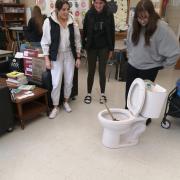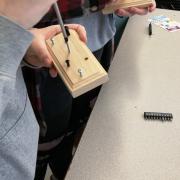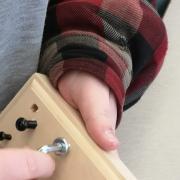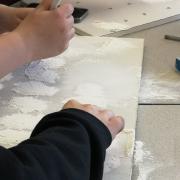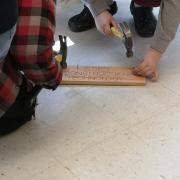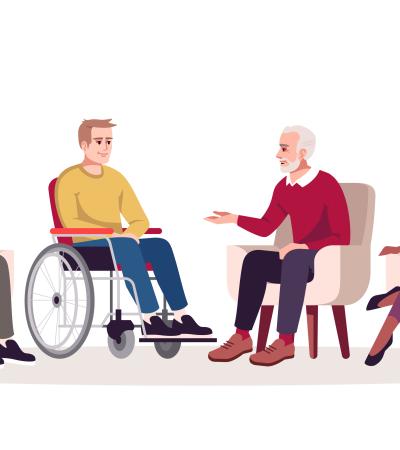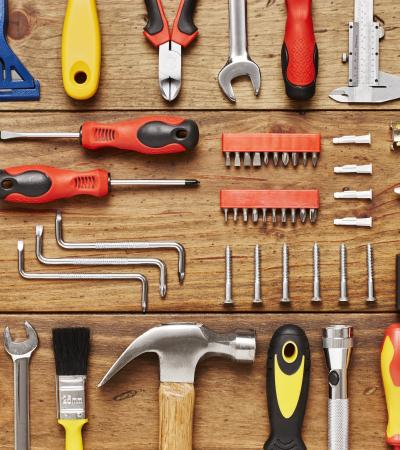The Fix It Workshop was conducted by Stratford Public Library's teen services librarian Brooke Windsor at Stratford District Secondary School. The workshop was a full class in practical adulting skills for teens in grade 11. Participants worked through various stations featuring simple repairs including:
- Matching screws to screwdrivers.
- Fixing holes in drywall.
- Jumpstarting a car with a cardboard battery rig.
- Hammering nails.
- Changing a lightbulb.
- Changing batteries in remotes (funnily enough only a quarter of the class knew this skill as so much is currently charger-based!).
- Using a plunger and reattaching a chain in the tank of a toilet.
Advanced Planning
I have a good relationship with the teacher at the local high school who teaches the Housing and Home Design course. We scheduled the Fix It workshop at the beginning of the semester so that we both had plenty of time to get things ready. Once the class period was booked for a specific day, I started to plan what skills were needed and could be turned into stations that I could bring into the school.
The only challenge for the planning phase was how awkward it was to walk into the local Home Hardware store and ask to borrow one of their display toilets for the day of the event. Thankfully, despite the weirdness, the store agreed to let me borrow their most basic floor model toilet and I offered to tag the store in the Instagram post for the program that was sure to grab attention.
Marketing
Marketing for this program was not needed as it was for a specific class at a specific school. Think of it like a school visit but for something unique!
Budgeting
Roughly $40 with spending on:
- A 2ft x 4ft piece of drywall that I cut in half.
- Drywall plaster.
- A few more plastic putty knives (than my own and a few we have for repair at the library).
- Sanding sponges.
- A few screw types that I didn't have lying around (specifically I didn't have any flathead screws in my toolbox and only one Allen bolt).
- A beginner tool kit that I bought on Amazon included basics that will serve them for a long time in the future. This kit was awarded at the end of the workshop based on a draw.
Everything else was scavenged from things we already had:
- Small cardboard boxes that I turned into a car battery using weight inside and plastic connector screws from our Makedo kit.
- Car jumper cables (my own).
- Remotes and batteries [both AAA and AA] (my own).
- Screwdrivers in a variety of shapes and sizes (my own).
- Lamp and lightbulb (my own).
- Plunger (my own that hadn't been used since I bought it).
- Wood for hammering (taken from broken pallets at the hardware store).
Day-of-event Activity
The first part of the day was to pick up the toilet from our local Home Hardware. One of the staff members did the lifting for me and I used my handy dandy collapsible wagon (nicknamed Jolene since I use her as a dolly) to get it to my car. The standard collapsible wagon can easily hold the weight of a toilet which is 40-90 pounds. We then buckled the toilet into my passenger front seat. The Vice Principal of the school then helped me get the toilet from my car back into Jolene to roll it into the classroom. This part went more smoothly than I anticipated because while the toilet was heavy, it wasn't as bad as I imagined.
It was myself and the teacher who set up the stations for each task that the students had to complete. The stations were spread out around the room and most of the stations could accommodate around three students at a time. Only the car jumpstart and change a lightbulb station could only have one person at a time.
Program Execution
"Why is there a toilet in our classroom?" - Avery, grade 11
This workshop managed to throw these students for a loop in the best way, and the atmosphere was humming with excitement. The workshop began with an overview of what we were doing and a step-by-step run-through on how to perform each task. Students were also given a "cheat sheet" handout. For every station completed, they got a ballot to put in the draw for the tool kit. Proof of completion was required with students filming or taking photos of the finished stations. This allowed the teacher and myself to float while still guaranteeing that the students completed the tasks. Some of the students kept their proof-of-completion simple while others went all out and treated it like a YouTube tutorial where they recorded themselves showing how to do something to an "audience" through their phone.
We had the entire class of 23 students participate (not a single student sat out) and even had a couple of students who had spare periods sneak into the room to join. For the tool kit giveaway, I put the ballots in the toilet bowl for added drama which the students seemed to love.
Since this workshop was part of a class period, the evaluation tools were kept simple. I used ad hoc feedback, a verbal survey, and listening to the students while they worked. All the students admitted to learning something new and all the students said they would most likely use at least one new skill at some point in the future. These results let me know that not only did the students learn valuable life skills but they understood that these skills had practical uses in their lives.
While I partner with the local high school so much that I have become an honorary staff member, this was our first time partnering with the Stratford Home Hardware. Despite the ask being downright silly, they were up to the task without question and were extremely excited when the photos were posted to fully understand what I was trying to do. They have offered to do more for the Fix It Workshop when we run it again — which we absolutely will do! It truly was an amazing day with lots of learning, lots of engagement from the students, and something they will never forget.
Advice
The advice for this program is simple: DO IT!

